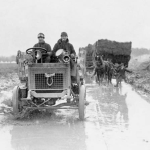Sunday, November 29, 1914
Camp Salisbury Plain, West Down South
The Battalion War Diarist wrote for this day: “Drill. Rain” [1]
 THIS DAY IN RMR HISTORY: “Canadian Press Dispatch: Ottawa, Nov. 29. – The British War Office is considering the use of long “beefskin” moccasins, such as are used by Canadian lumbermen, for the men at the front this winter. The moccasins as manufactured in Canada are waterproof, and with thick heels and heavy soles attached would likely prove a great boon to the men bearing the brunt of the fighting. Many orders for such moccasins have already been received from the men in the Canadian contingent.
THIS DAY IN RMR HISTORY: “Canadian Press Dispatch: Ottawa, Nov. 29. – The British War Office is considering the use of long “beefskin” moccasins, such as are used by Canadian lumbermen, for the men at the front this winter. The moccasins as manufactured in Canada are waterproof, and with thick heels and heavy soles attached would likely prove a great boon to the men bearing the brunt of the fighting. Many orders for such moccasins have already been received from the men in the Canadian contingent.
Lieut.-Col. Murphy who was Transport Officer in the first Canadian contingent, and who went to England on a special mission for the Militia Department, returned to Ottawa to-day. He highly recommends such footwear for the use of the troops.
 Lieut.-Col. Murphy said that when he left Salisbury Plain part of the contingent had removed into huts and indications pointed that the Canadians would not go to the front until after Christmas at least.” [4]
Lieut.-Col. Murphy said that when he left Salisbury Plain part of the contingent had removed into huts and indications pointed that the Canadians would not go to the front until after Christmas at least.” [4]
[1] War Diary, 14th Canadian Battalion, The Royal Montreal Regiment, Nov 29, 1914. Library and Archives Canada, Ottawa, http://data2.collectionscanada.ca/e/e044/e001089676.jpg
[2] http://vimyridgehistory.com/kit-1/cda-rallies/salisbury-plain/images/#gallery/2198/514/0
[3] “Beefskin Moccasins For Troops At The Front,” The Globe (1844-1936), Toronto, Ontario, Monday, November 30, 1914, pg. 2, col. 3.
[4] Ibid.

